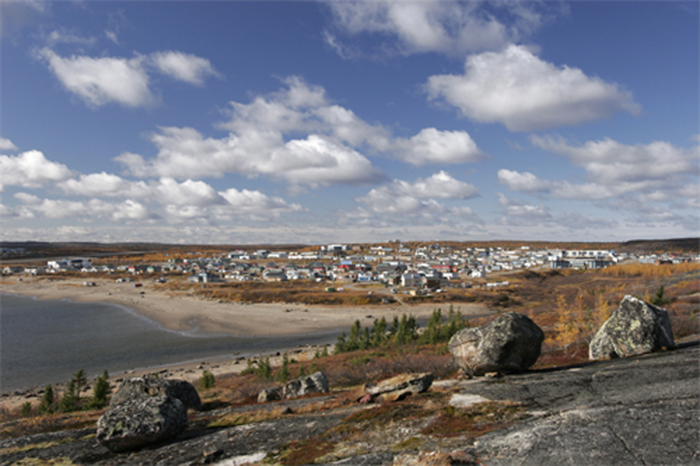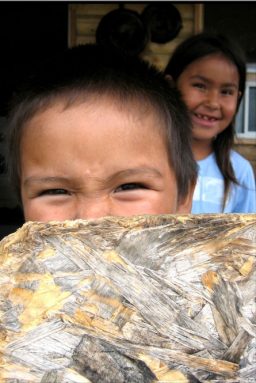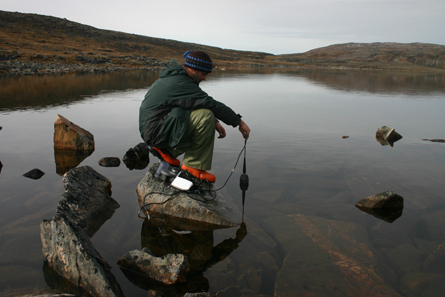Pollution at the ends of the Earth
Chemicals are turning up in small Arctic villages far from factories and cities

The village of Kuujjuaq, in northern Canada, is home to about 2,100 people.
Orbitale/Wikimedia Commons
By Douglas Fox
No roads lead to Kuujjuaq. You can only get to this village, high in the Canadian Arctic, by boat or plane. The trees here are stunted and small, but the bears grow big. The 500 kids who live in Kuujjuaq (pronounced KOO-joo-ak) have unusual chores: they help their parents catch fish and hunt caribou to eat. This place might seem far away from the big problems of big cities, like water pollution and air pollution. But even here, people can’t escape those problems. Pretty little Kuujjuaq, with its blue skies and crystal clear waters, also has an invisible pollution problem that rivals any city.
Toxic chemicals have a surprising way of finding their way up here to the Arctic. They are gushed out of factories and cities thousands of miles away, and they travel to the Arctic like birds flying north for the summer. The birds go back home, but the chemicals stay.
Everyone in Kuujjuaq has the chemicals in their bodies. No one knows their full effects, but they may hurt children in a slow and silent way. They could cause babies to get sick a little more often. And they might even cause kids to do worse in school.
No one would have dreamed that people in such a clean and beautiful place could be hurt by pollution from thousands of miles away. Then, in 1989, some scientists made a discovery.
POPs around the world
Eric Dewailly, a doctor at Laval University in Québec, Canada, was studying chemicals called persistent organic pollutants, or POPs. These are chemicals that can hang around for a long time in people’s bodies or in the environment.
Dewailly and his team tested people in the cities of southern Québec (near the border with the United States) to see how much of these chemicals were in their bodies. Dewailly’s team wanted to compare this group with people in the Arctic. They reasoned that people in the Arctic lived far from pollution, and so would probably have lower levels of POPs in their bodies.
So the scientists went up to Nunavik, the remote, northern part of Québec which includes Kuujjuaq and 13 other native Inuit villages. When they tested people in Nunavik they were surprised. People there had five to ten times as much of these chemicals in their bodies as people living in polluted cities. Some of the chemicals came from as far away as Russia!
Scientists now understand why this happens. The POPs include hundreds of different chemicals. Some are used in electronic gadgets like TVs, or in the lights and electrical wiring of buildings. Some are used in paints or for making windows waterproof. Others are sprayed onto crops as pesticides. But POPs have one thing in common: They like to evaporate. Just as a puddle of water dries on a hot summer sidewalk, POPs turn slowly into vapor and drift into the air. Winds can carry them thousands of miles.
POPs travel in the air until they reach a cold place. Have you noticed that on a hot day, a glass of lemonade with ice cubes in it collects little drops of water on the outside? This is because water vapor, which is a gas in the air, “condenses” onto the cold glass and forms those droplets—the opposite of evaporating or drying. The same thing happens with POPs, says Knut Breivik, an environmental chemist at the Norwegian Institute of Air Research in the city of Kjeller.
“Things tend to evaporate in warmer regions and condense when it gets colder,” says Breivik. So when winds carry POPs into the Arctic or Antarctic parts of the world, cold temperatures cause them to condense onto plants or rocks or snow or oceans. And then they stay where they landed and build up over time.
10 million tons
Over the years, more than 10 million tons of POPs have probably floated through the skies to the Arctic. If those chemicals were piled on an area the size of a football field, the pile would rise 700 meters in the air—higher than the tallest building on Earth.
Since the chemicals are spread over the entire Arctic instead of a football field, there’s actually only a small amount in any one place. A swimming pool filled with Arctic Ocean water might contain only a single tiny raindrop of POPs. But these chemicals have a nasty habit of collecting inside animals and people, so even a little bit in the environment can end up causing problems.
POPs tend to stick to the oils and fats in living things, so tiny ocean animals like plankton soak them up, just like a shirt soaks up a drop of spaghetti sauce. Those plankton are eaten by larger animals, which in turn are eaten by even larger animals.
Every time one animal eats another, more POPs enter the larger animal’s body. Animals can’t digest POPs. They take them in the front, but never poop or pee them out the back end. So the POPs collect and collect. The biggest animals, like sea birds, seals, and whales, have the most POPs in their bodies. And these animals are eaten by native Inuit people, who have lived and hunted in Nunavik and other parts of the Arctic for thousands of years.
Two teaspoons
By the time a boy growing up in Kuujjuaq turns five years old, he may have collected one or two little rain drops’ worth of POP chemicals in his body. That doesn’t sound like much—but it’s thousands of times more concentrated than these chemicals are in sea water. In fact, that little boy has as much of these chemicals in his 20-kilogram body as there would be in two and a half million kilograms of sea water—in other words, enough sea water to fill an Olympic swimming pool! Scientists are trying to understand how the chemicals affect kids.
 |
|
Kids in Kuujjuaq play and joke around.
|
| André Perron/Wikimedia Commons |
Dewailly’s team has made many trips back to Nunavik to study the problem of POPs. In 1992 and 2004, they sailed in a ship to all 14 villages along the coast of Nunavik, including Kuujjuaq. The ship stopped at each village, and doctors took blood samples and examined people. They measured POPs in hundreds of newborn babies. Blood samples were taken again when the babies turned one year old. And these babies were studied for years as they grew, to find out how the POPs in their bodies affected them over time.
These studies have shown that POP chemicals affect the health of children in small but worrying ways. For one thing, these chemicals can weaken children’s immune systems, says Pierre Ayotte, a toxicologist who works with Dewailly at Laval University. “Then you’re less able to fight disease,” he says. Babies with the most POPs in their bodies had more ear infections and more infections in their lungs—not minor infections like colds or flu, but serious ones that affect breathing and can sometimes send you to the hospital.
Long division
These chemicals might even affect how well kids do in school. When the babies were 1 year old, the Laval University scientists gave them some tests. They tested how well the babies used their hands. They also tested how well the babies paid attention and learned when they were shown new toys. All of these tests were videotaped, and scientists carefully studied the videos afterward. What they saw surprised them.
Babies with high POPs levels weren’t quite as coordinated with their hands as other babies. They also didn’t pay attention quite as well when they were being shown new toys—they often stared away at other things. And during several hours of tests, these babies became upset and cried more often.
These were small differences. You wouldn’t notice them unless you watched the babies closely. But when the same babies were tested again at the age of 5, the ones with high POPs still did a little worse.
“At later ages you’re still at a disadvantage,” says Gina Muckle, a psychologist on the Laval University team that traveled to Nunavik to test the children. Muckle thinks that even small changes can affect how children do in school as they get older. They could affect how a child responds when taught something hard, like long division—whether they meet the challenge with a positive attitude, or get upset and discouraged. Or they could affect how a child responds to the stress of going to a new school—how well they make new friends, and whether they still do well in class during those awkward times. Little differences, over the years, could add up. “Those effects,” says Muckle, “are likely to be a real disadvantage overall during the life of the person.”
Still trickling
No one was happy to learn that POP chemicals were hurting people in the Arctic. But finding out about the problem gave the Inuit a chance to do something about it. In the 1990s, the United Nations held a meeting, called the Stockholm Convention, to discuss banning many POP chemicals. The Inuit sent people to the United Nations to tell how POPs had affected them. Since 1998, 140 countries have agreed to stop making many POP chemicals. As a result, levels of POPs in the Arctic are falling.
But it will take a long time for the problem to go away. For one thing, buildings around the world still contain many tons of POPs in their paint and wiring. Every day, a little bit of those chemicals turns into vapor and drifts outside. Eventually, it reaches the Arctic.
 |
|
Researcher Sébastien Roy tests the quality of a lake’s water during the 2004 Nunavik Health Survey.
|
| Isabelle Dubois/NRBHSS |
Soil also contains huge amounts of POP chemicals—and the hot blast of a forest fire can send them into the air, just as a hot blow drier causes water to evaporate from your hair. Breivik found that major fires in 2004 and 2006 caused large amounts of POPs to go into the air and reach the Arctic. Many of these chemicals last for 100 years or longer.
Likely suspects
The other problem is that while hundreds of POP chemicals are known, there are probably others that scientists still don’t know about. “There are new compounds that are ending up in remote areas,” says Frank Wania, an environmental chemist at the University of Toronto in Scarborough.
Many POPs contain the element chlorine. But in the last few years, scientists like Wania have been surprised to find that two families of manmade chemicals, which contain the elements fluorine or bromine, have found their way into the Arctic. “We failed to recognize [them] until they were already accumulating in the Arctic,” says Wania—meaning that large amounts of them were turning up in seals, birds and people. By the time the chemicals were discovered and banned, the damage was done.
Scientists want to get ahead of the problem. Wania has surveyed 100,000 industrial chemicals. He was looking for chemicals—you could call them “hoppers,” “fliers” and “swimmers”—which might reach the Arctic. Out of those chemicals, he found 120 likely suspects that he plans to look at more closely.
All of this might seem like a lot of effort. But many scientists think it’s the right thing to do. It comes down to one question, says Muckle—whether we want children to be able to grow and learn to their full potential. “The environmental contaminants are certainly an issue,” she says. “As a society we need to take that into account.”







